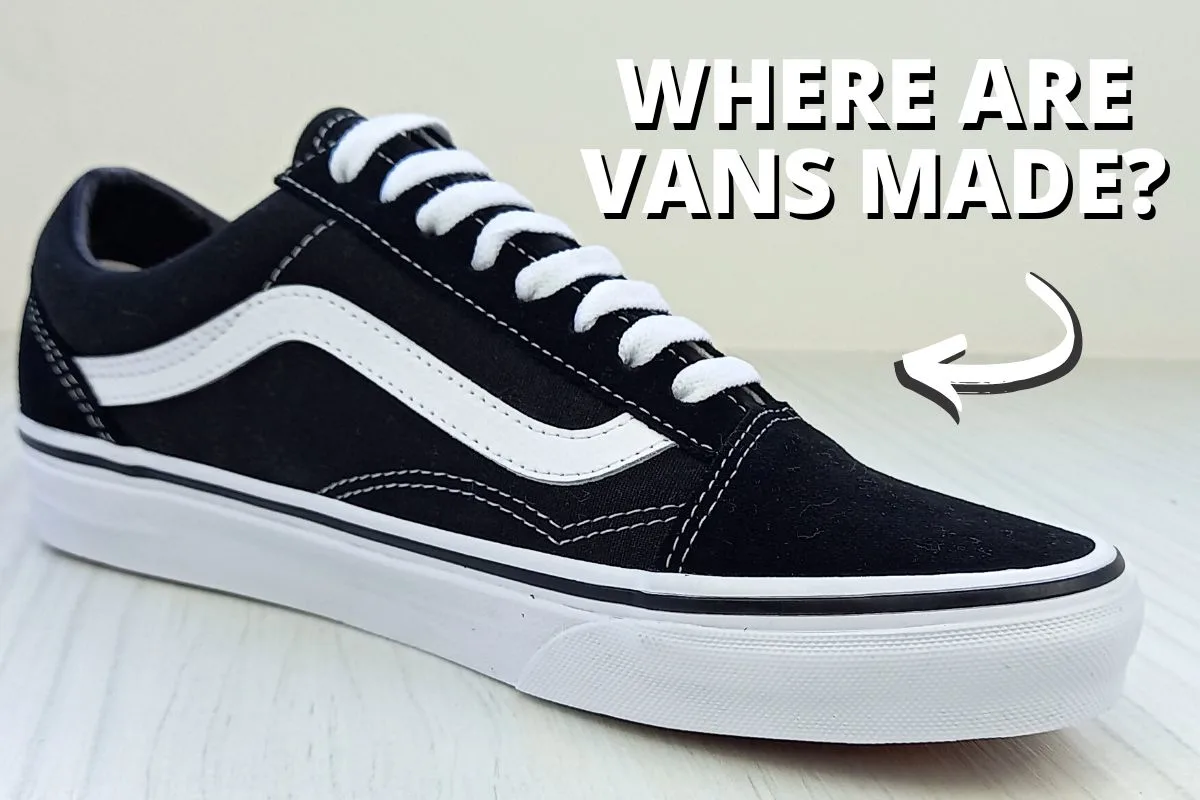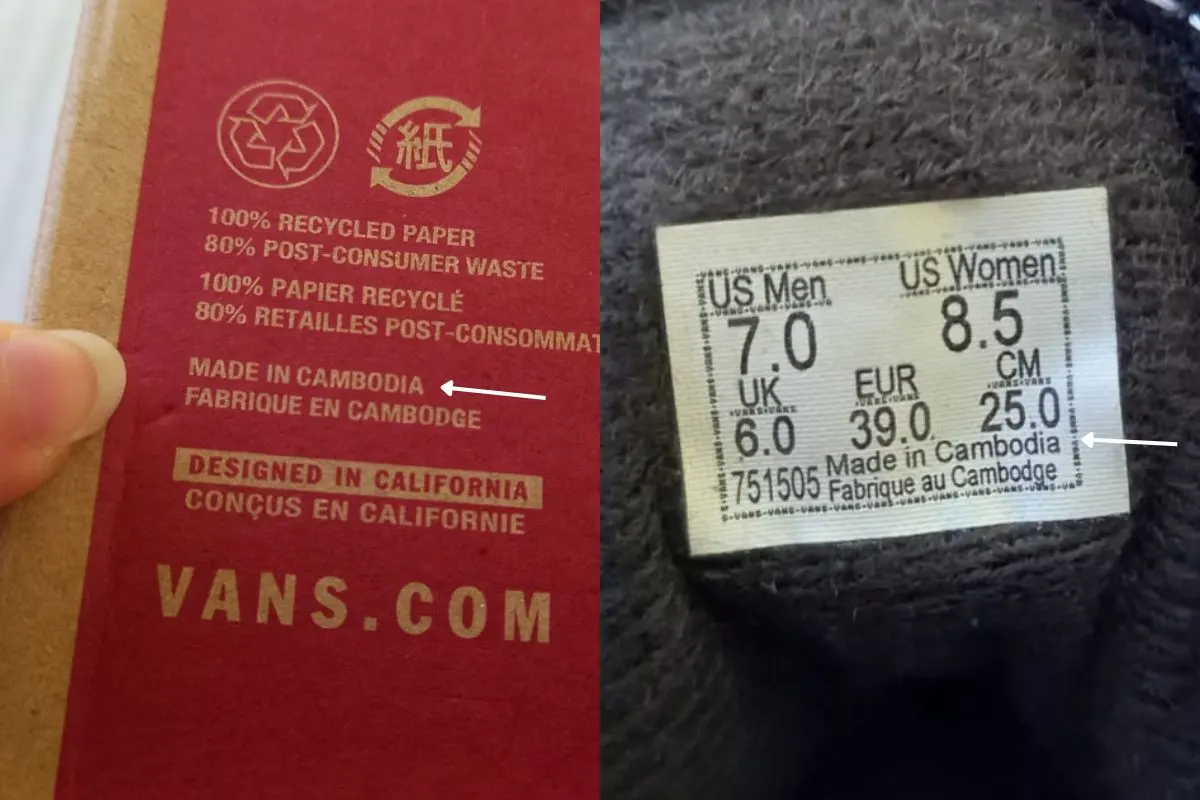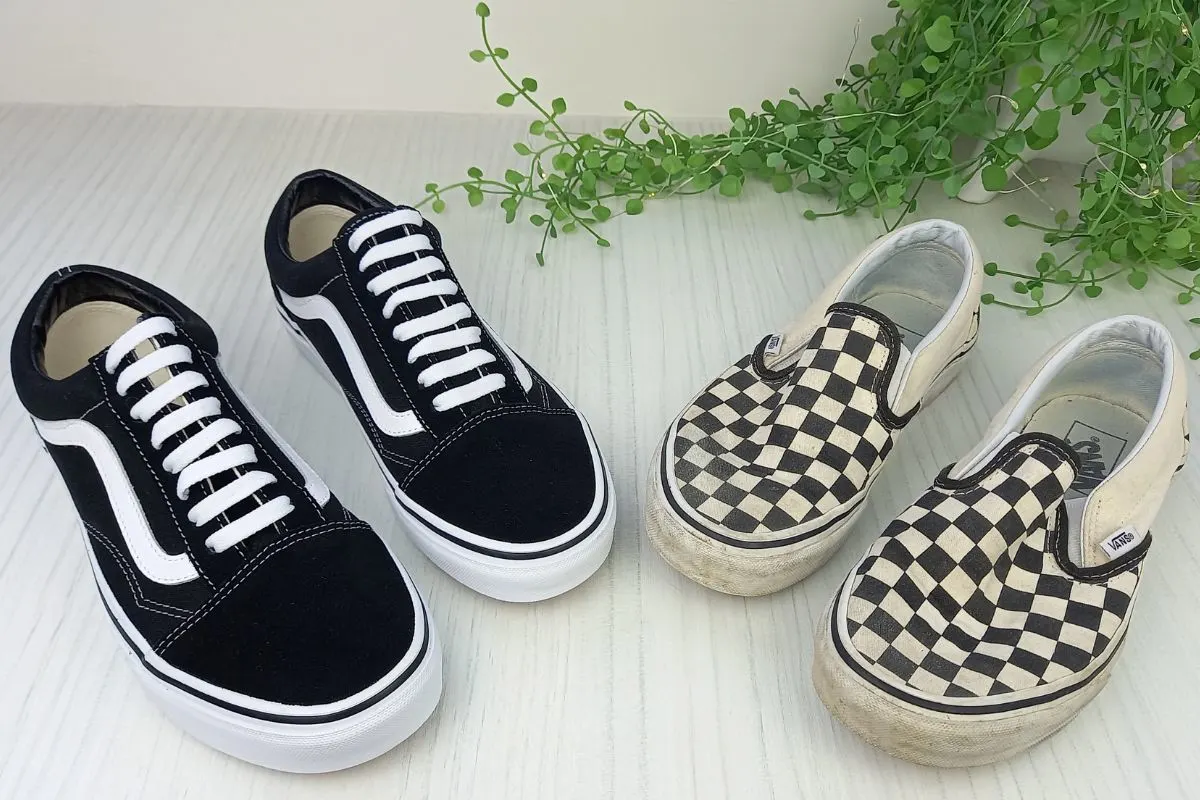If you’re a skateboarder, surfer, BMX cyclist, snowboarder, or just enjoy cool colorful footwear, chances are you either own at least one pair of Vans shoes or you’ve admired them on the feet of others. The history of Vans began in 1966 in California. The company is still based there, with headquarters in Costa Mesa, but where are Vans made?

Since 1993, Vans have been made in various countries in Asia and in Eastern Europe. In 1995, Vans closed its plant in Orange, California. China is the biggest manufacturer of Vans products, followed by Vietnam and Cambodia. Apparel and accessories are made in Georgia, Serbia, Bulgaria, and Turkey.
My own pair of Vans are made in Cambodia. You can see this marked on the underside of the shoe box and on the label on the inside of the Vans tongue in the below image:

You may be wanting to know where Vans are made if you are trying to authenticate your own pair. If that’s the case you may find this guide helpful too: Fake Vans vs Real Vans: 15 Ways To Spot Fake Vans (Photos).
Vans has a history as colorful as its sneakers, and the road to its present dominant position in the world of sports apparel makes for fascinating reading. We’ll look at the scale of their operations in the various countries, what products make up the Vans range, and how they have made their mark in the various aspects of American and international culture.
Where Are Vans Made – Past And Present
When we talk about Vans, we tend to think of their instantly recognizable casual footwear. But their product range extends to athletic footwear, apparel for men, women, and children, and accessories.

Where Are Vans Shoes Made?
The question is simple, but the correct answer is a little more complicated – each component comes from different parts of the world.
- The cotton in a Vans shoe makes up around 13% of its total weight. The cotton is processed in textile plants such as the one in Yancheng, China, and the fabric printed in Vans’ famous patterns originates mainly in South Korea.
- The leather used in some of Vans’ shoes is sourced in India, where it is processed and shipped to the Vans shoe assembly plants in China, Vietnam and Cambodia.
- The rubber soles come from factories such as the one in Fresno, California.
- The plastic in the shoes, found mainly in the shoelace tips and eyelets, comes from a plastics factory in Wolcott, Connecticut.
When one considers that about 80 million pairs of Vans shoes are made and sold annually, the logistics of ensuring the efficiency of the supply chain from the various suppliers to the assembly plants and then to distributors, and finally to retailers is simply mind-boggling.
You may also like: Why Are Vans So Popular? 2022 Style Report
Where Were The First Vans Shoes Made?
We’ll look briefly at the history of Vans, taking a glimpse into the past to compare the origins of the brand in the context of that figure of 80 million pairs of Vans sold annually.
Paul Van Doren was an executive in one of the country’s largest shoe manufacturers but was frustrated by the low profit margins compared with the retailers they supplied. With his brother James Van Doren and two partners, Gordon Lee and Serge D’Elia, he established the Van Doren Rubber Company to manufacture and sell quality casual shoes directly to the public.
Van Doren’s vision was to create a quality canvas sneaker that would appeal to young Californian surfers and skateboarders but was priced so that they could afford them. In the early ’70s, skateboarding became as big a sport as surfing, and Vans, with their sticky, robust rubber soles, were the perfect choice for this burgeoning market.
After a year of building and equipping their factory, in 1966, March 16th to be exact, the first Vans store opened in Anaheim, California. That first morning seventeen customers came through the door.
Twelve pairs of shoes were sold, but the Van Doren brothers didn’t have change to give the customers. Nor did they have any stock apart from three design samples and a display full of empty shoeboxes. The purchasers were told to come back later to pay, and the twelve pairs were made on the premises before the end of business that day!
Early designs were numbered, and the first Vans shoe sold was known as the #44. The next design was #95, followed by #36. Those designs are still around today, as the Authentic, the Era, and Old Skool, respectively.
The Van Dorens opened ten stores in the following months, but half were unprofitable, and they were advised to close them. Fortunately, they ignored that advice, opening new stores at the rate of one per week in 1967. By the end of the ’70s, there were 70 profitable stores operating in California, and Vans were worn by skaters, surfers, and the young Californian in-crowd in increasing numbers.
You may also like: How To Lace Vans – 7 Cool Ways (EASY guide)
Vans Were Made In America For Decades
Production of Vans skateboarding shoes was all-American for nearly thirty years, in several factories in California. Throughout the ‘60s and ‘70s, Vans capitalized on the growing skateboard culture that had spread from California and the West Coast across the country and worldwide. Vans stores were opened across California, and their widening range was also sold through independent retailers countrywide.
From those humble beginnings in Anaheim, Vans became renowned for their high-quality canvas shoes with their waffle-patterned sticky rubber soles, but above all, their eye-catching designs. Their success was the epitome of the American Dream, based on a quality product, a vision, and a family with enormous entrepreneurial energy.
Production of Vans shoes centered around the massive 176,000 square feet plant in Orange, California. Even when other shoe companies were starting to migrate their production to the Far East, van Doren resisted following them and continued to manufacture locally.
Where Are Vans Made Now?
Trade figures show that 98% of Shoes sold in the USA are produced outside the country. While China is still the largest producer, the situation is changing. The tariff war between China and the US has something to do with it, but cost factors are also an important factor.
China’s average wage for factory workers has increased dramatically in the last few years, and there is now only a 4% differential between the production costs of the two countries. No figures are available showing the geographical breakdown of Van’s shoe production, but there is a definite swing toward other Far East countries as alternative manufacturing locations.
Certainly, a healthy proportion of Vans shoes, as well as their range of accessories and apparel, are now made in Vietnam. Wage levels are lower than in China, skill levels are as high, and the quality of the product is not compromised by this move. For the same reasons, Cambodia is now a preferred manufacturing country, and some Vans products are produced there.
Apart from Asia, some Vans products are produced in Serbia, Bulgaria, Georgia, And Turkey. These products are mainly in the accessory and apparel divisions as opposed to shoes, as quantities are insufficient to justify using the mass-producing plants in China and Vietnam. For example, Georgia is a somewhat surprising manufacturing country for some Vans t-shirt lines.
Why Are Vans Now Made Outside Of The USA?
In 1976 Paul Van Doren handed over control of the company to his brother James and retired. Under James, Vans moved into a growth phase, opening new avenues in different sports, including football, basketball, soccer, baseball, boxing, and skydiving.
Labor Issues Became A Problem
Vans also opened a massive production plant in Orange and increased its labor force to over 1,000 workers. An unfortunate labor issue, with the company being raided in 1984 by immigration officials, led to it being found guilty of employing illegal migrants and being heavily fined. In addition, to make matters worse, 150 of their workers were arrested during this raid.
The Heavy Price Of Fame
In 1982 Sean Penn was instrumental in turning Vans into even more of an iconic brand when he wore checkerboard slip-ons in the movie ” Fast Times at Ridgemont High.” The skateboarding origins of Vans crossed over into broader pop culture, but it led to a vast number of fake copies at unsustainably low prices, flooding the market, as well as a price war with legitimate competitors.
The company also faced ever-increasing competition from new entrants into the market. With these copycat and counterfeit products eating into their profits, the company’s financial strength was seriously threatened.
To counter these pressures, Vans tried to diversify its style range and cut prices, with disastrous results, and the company filed for bankruptcy in 1984. James Van Doren was forced to hand control back to his brother Paul.
The Rebirth Of The Company Brought Changes
With an experienced hand back at the wheel, the company’s fortunes showed a remarkable turnaround. By 1987, Vans had repaid all creditors at 100 cents in the dollar, and their $12-million debt was wiped out. The bankruptcy was lifted, and in 1988 the Van Dorens sold the company to banking firm McCown De Leeuw & Co. for $74.4 million.
By 1991, demand for Vans shoes far exceeded supply, and it was essential to ramp up production. Despite having resisted the move for years, in 1993, the first Vans shoe produced outside of the US was manufactured in South Korea. By the late ’90s, almost the entire shoe production had been relocated to that country.
Having had problems with migrant labor in the past and run-ins with labor unions, Vans was unable to avoid this logical move. Skilled labor was less expensive, supply chains were shorter, and as a result, production costs could be reduced without sacrificing quality.
Marketing Vans Instead Of Making Them
Vans closed their manufacturing facility in Orange, California, in 1995 while retaining the 90,000 square feet plant they had built in 1992 in Vista, California. However, in August 1998, the company announced the closure of this last remaining manufacturing facility, with the loss of three hundred workers.
The closure was the result of a decision made to convert Vans from being a manufacturer of sporting goods with its own retailing arm to a marketing organization. The policy was to promote the company’s products to their fiercely loyal customers and create new ones through intensive and focused shared involvement in their activities.
This new direction has proved spectacularly successful over the ensuing years. After a dip during the Covid pandemic, sales now top $9 billion annually.
Vans Are Made Elsewhere But The Marketing Stays In The USA
Having shown why Vans are no longer made in the USA, we shouldn’t ignore their strong American roots. They remain an American brand, and as a marketing-oriented company, Vans still promotes and sponsors many US-based activities.
- As part of this emphasis on marketing, the company opened the country’s largest skate park in Orange, California.
- They also sponsor a range of Triple Crown events, including skateboarding, snowboarding, and surfing.
- From 2001 to 2019, Vans sponsored the Warped Tour, the country’s largest musical tour.
- Vans sponsors the US Open of Surfing in Huntington Beach, California.
Some Famous Names Are Part Of Vans Collaborative Marketing
From the early days of Vans, when Paul Van Doren preferred giving sneakers away to surfers rather than advertising, the company has collaborated with individuals and firms in creating new designs and limited editions of their famous styles. These include:
- Tony Alva and Stacy Peralta – professional skaters who created the Vans Era in the’60s
- Iron Maiden and Vans created The Number Of The Beast limited edition
- Metallica collaborated in a range of Vans shoes with designs by Metallica artist Pushead
- Peanuts and Vans have had a long collaboration with a full range of Snoopy, Charlie Brown, and Lucy designs for men, women, and kids alike.
- Star Wars and Vans have a long association far beyond just the logo and have created a six-piece classic collection.
In these innovative marketing collaborations, Vans have a unique means of communicating and interacting with its customers, and it has kept the brand very much at the forefront of a very competitive market.
Are Vans Made In The USA?
In 2017, as part of their marketing drive, Vans produced their first “Made In America” shoes in over twenty years, the Style 113 Pro USA ArcAd. Only 700 pairs were made, in two different colorways, making them highly sought-after and very collectible. No doubt this successful campaign will be repeated in the future, but we don’t have any information regarding any definite plans to make any other Vans in the US.
My research has also brought up the fact that, when customizing a shoe or any other Vans product, the actual customizing is done in the US, even if the basic product originates in Vietnam or China.
What Makes Vans So Popular?
With around eighty million pairs of shoes sold every year, generating $9 billion in sales, Vans has shown meteoric growth in the fifty-six years since those first twelve pairs of shoes were sold.
Despite a difficult time in the eighties, demand has shown steady growth every year, and Vans is the brand of choice for skaters, surfers, the rich and famous, as well as the man in the street.
There’s More To Vans Than Sneakers
What makes Vans such an iconic brand? There are more than sixty different shoes in the Vans sales catalog, even though their early designs still account for a large portion of the $ 9 billion. Some of these include:
Shoes
- The Classics: Authentic, Era, Slip-on, Old Skool, Sk-8 Hi, Half Cab
- Sports: Surf Boots, Slip-Ers, BMX, and Skate Designs in Sk-8, Old Skool, and Half Cab
The full range of shoes is available in Men’s and Women’s, in regular and wide, and there is a range of kid’s and toddlers’ shoes as well.
But adding To Van’s strength in the marketplace is the brand-related products which are aimed at providing their clients with a complete coordinated Vans “look”:
Accessories
- For men, these include beanies, caps, backpacks, socks, bags, sunglasses, and belts.
- For women, beanies, hats, fannypacks, socks, caps, tops, sunglasses
Apparel
Vans produce a wide range of long- and short-sleeved t-shirts, hoodies, jackets, sweatpants, shorts, and tops for men and women.
Conclusion
Vans are no longer made in America, apart from very few exceptions. Almost all Vans, whether it’s shoes, accessories or apparel, are made in Asia and Eastern Europe. Nevertheless, the brand is very much still American because of its unique marketing policies, management team, and adherence to the classic West Coast styles it created in California in the ‘60s.
For more Vans content, check out:
How To Lace Vans Old Skools (Standard Way)
Are Vans Good For Wide Feet? (Size Guide FAQs)
Are Vans Waterproof? ULTIMATE FAQ Guide
Are Vans Non Slip? A Test on 4 Surfaces (FAQ Guide)
How To Break In Vans (7 FAST and Painless Ways)

Lorna is a footwear geek and the founder of Wearably Weird. She created a YouTube channel in 2021 for fellow footwear fanatics, dedicated to detail-rich footwear reviews and info. She has a fashion media qualification (awarded in 2011).
